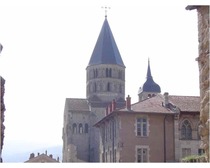Cluny Abbey is an ancient monument situated in France. Check out some interesting and fun facts about Cluny Abbey.
Facts About Cluny Abbey
The Abbey of Cluny, as the name suggests, is an abbey located in the town of Cluny, in the country of France. It was a significant center of a major monastic movement in the middle ages. Though the building is primarily in its ruins now, as much of it was destroyed in the 18th century, it still exudes its ancient majesty and splendor. Currently, only one transept of the 12th century abbey church remains, along with 15th century Abbots' residences and convent buildings of the 18th century. All these sites are surrounded by pleasant gardens and a museum containing Romanesque relics. Initially, the abbey was built as one of the chief Benedictine monasteries of its time and became one of the focal structures that brought stability to the European society. The establishment of this abbey was once linked to the town of Cluny although today, it lacks any connection whatsoever. If these facts have interested you and you want to know some more interesting and fun facts about the Abbey of Cluny, read on.

-
The Abbey was founded by William I, Count of Auvergne, in 910 AD.
-
The Church of the Abbey was the largest church in the world, before the construction of St. Peter's Basilica.
-
The Abbey of Cluny is a Christian Monastery.
-
The abbey was founded by Benedictine monks, to observe a closer adherence to Benedictine rules.
-
Cluny Abbey was initially presided over by Abbot Berno and supervised by Pope Sergius III.
-
The Cluny Abbey stood as a symbol of the ‘continuity’ of architecture.
-
Did you know that the Cluny Abbey influenced the construction of a number of other great French monuments such as ‘Paray-le-Monial’, ‘La Charite-sur-Loire’ and ‘Autun Cathedral’.
-
The liturgy at the abbey used to be extensive, reflecting the wave of change of the 11th century.
-
During the 12th century, Cluny Abbey was the head of the 'monastic empire', including 10,000 monks.
-
In 1098, Pope Urabn II declared the Cluny as the 'light of the world'.
-
The entrance to the Abbey is known as Porte d'Honneur.
-
A national horse-breeding center (haras) was founded by Napoléon in 1806 and constructed with materials from the destroyed abbey.
-
In 18th century, an elegant pavilion was built as monastic cloisters.
-
The roof of the flour store of the Abbey was built in 13th century. It is made of fine oak and chestnut and also contains a collection of exquisite Romanesque capitals.
-
The war of religions and the French Revolution destroyed the Abbey in 1798. The remaining part was sold or dismantled.
-
The Ochier Museum contains masterpieces of Romanesque sculptures.
-
The church in the Abbey was 656 ft. high.
-
At one point of time, the Cluny library was considered to be the richest and most important, not just in France, but in the whole of Europe. It was a storehouse, containing a large number of very valuable manuscripts.
-
Inside the abbey, there are five radiating chapels and double transepts near the apse.
-
Many of the items in the Cluny library were destroyed after the sacking of the abbey by the Huguenot in 1562. Many volumes fell in private hands and many got dispersed, which could not be recollected.
-
The Cluny customs represent a certain shift from the earlier ideal of a Benedictine monastery, which was a unit similar to the contemporary villa that survived in the more Romanized parts of Europe.
-
Cluny Abbey suffered from colossal financial problems with the beginning of 12th century. The construction of the third abbey caused this economic problem. Expenditure increased due to the donations granted to the poor.
-
The Abbey was mostly destroyed during the French Revolution in 1790 and was then restored.


More from iloveindia.com
- Home Remedies | Ayurveda | Vastu | Yoga | Feng Shui | Tattoos | Fitness | Garden | Nutrition | Parenting | Bikes | Cars | Baby Care | Indian Weddings | Festivals | Party ideas | Horoscope 2015 | Pets | Finance | Figures of Speech | Hotels in India : Delhi | Hyderabad | Chennai | Mumbai | Kolkata | Bangalore | Ahmedabad | Jaipur
- Contact Us Careers Disclaimer Privacy Policy Advertise With Us Lifestyle Sitemap Copyright iloveindia.com. All Rights Reserved.






